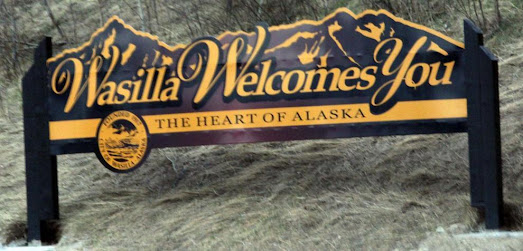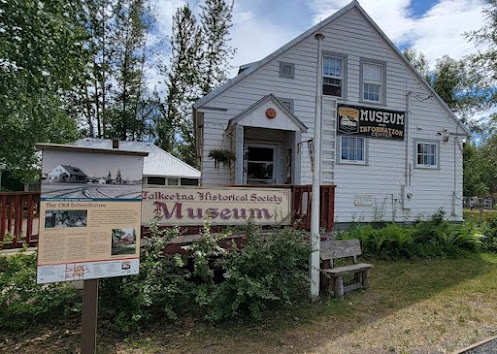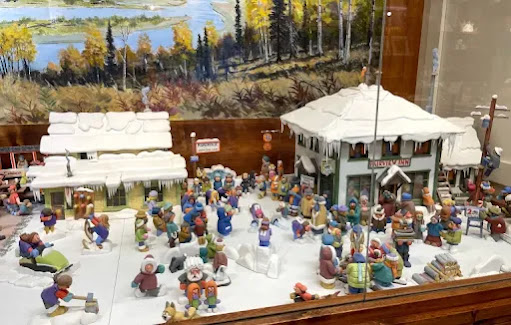Today as we started off toward Talkeetna, Alaska, it was another cloudy, rainy day with the temperature starting at 53 degrees. We left around 8:55 a.m. and arrived in Talkeetna at around 10:45 a.m. as we only had 91 miles to drive.
The clouds hung very low this morning as we travelled on the Parks Highway (Alaska Hwy 3 North) and then followed the Talkeetna Spur North.
We drove through Wasilla, Alaska on our way. Wasilla has a population of 9,200 and was a farming settlement in the 1930s. It began as a station on the Alaska Railroad in 1917. Wasilla started as a blinking yellow light on the Parks Highway -- it was the spot where the Carle Wagon trail between Knik and Hatcher Pass crossed the railroad track. The Iditarod Race Headquarters is located in Wasilla on the Knik-Goose Bay Road.
And then we drove past Houston, Alaska. Houston has a population of 1,558. Houston is a popular fishing center for anglers on the Little Susitna River. Houston was homesteaded in the 1950s and incorporated as a city in 1966.
We continued on until we drove past Willow, Alaska. Willow has a population of 2,102 and is best known as the official starting location for the annual Iditarod Trail Sled Dog Race. The small town of Willow is set in the gorgeous Mantanuska-Susitna Valley. Willow had its start in 1897, when gold was discovered in the area. In the early 1940s, mining in the nearby Talkeetna Mountains slacked off, leaving Willow a virtual ghost town. The community made a comeback upon completion of the Parks Highway in 1972. In 1976, Alaska voters selected the Willow area for their new capital site, however funding for the capital move from Juneau was defeated in November 1982.
As we passed Montana Creek Campground, we then saw a sign pointing to Talkeetna.
Only 14 miles and we will be in Talkeetna, Alaska.
We drove by the Alaska Railroad Talkeetna Station.
And we finally arrived at the little town of Talkeetna. Talkeetna has a population of 876 and an elevation of 346 feet. The historic community of Talkeetna (pronounced tall-KEEt-nah) sits near the base of Denali, North America's highest peak. Located on the Talkeetna spur road at mile 99 of the Parks Highway, the road leads north 14 miles to Talkeetna, dead ending at Talkeetna's Main Street.
Talkeetna is situated at the confluence of the Talkeetna, Susitna and Chulitna rivers. Talkeetna is an authentic Alaska pioneer town with historic buildings and log cabins lining the one-block-long main street.
Talkeetna began as a trading post in 1896 and grew as a riverboat supply base following the Susitna River gold rush in 1910. The population boomed during construction of the Alaska Railroad, but declined following completion of the project.
The Talkeetna Historic District encompasses several blocks of the historic village center of Talkeetna. It includes buildings on Main Street, between C and D Streets, along with a few buildings on C and D Streets between Front and East First Street. The village was established in 1916 as a regional construction headquarters of the Alaska Railroad, and became a home to area miners after the railroad's completion. The district includes three buildings that date to the time of the railroad construction, and another ten that were built before 1940. Most of the buildings in the district are one or two stories in height, and are either of wood frame or log construction. Notable among them are the Fairview Inn, the town's first schoolhouse, now the Talkeetna Museum, and the Talkeetna roadhouse, which was built as a residential log house in 1917 and expanded in the 1940s to serve as a roadhouse.
We drove through town down Main Street looking for a campground to stay at for the night.
We drove by Talkeetna Camper Park, and checked with them to see if there was any availability for the night. They were all full with no availability due to the upcoming Fourth of July holiday.
However that campground was kind enough to call another place -- the Swiss Alaska Inn -- to see if they had anything available. And as luck would have it, they did.
We drove over to the Swiss Alaska Inn and Mel went into talk with them and they had a spot for us just across the road. So at 10:45 a.m., we had a full hookup site for one night for $41. The mosquitos were really bad while we were getting set up -- you simply had to keep moving and swatting at mosquitoes at the same time. After we got all set up, we then drove into town.
We first stopped at The Patchwork Moose Quilt Shop where I bought a row-by-row quilt pattern with sled dogs called "Alaska Winter Fun."
Our next stop and probably the best stop of the day was at the Talkeetna Spinach Bread food truck (family owned since 2001). I was skeptical, as I don't really like spinach -- but this was awesome! So delicious and an absolute culinary delight! Mel and I both had a piece of Spinach Bread for $9 a piece.
Talkeetna Spinach Bread, their namesake/signature dish is an Alaskan favorite! The spinach bread is a special creation made with spinach, a special blend of cheeses, roasted garlic, served hot and toasty on hearty wood-fired spent grain bread. And they make it in a vintage Airstream trailer and have been making it for over 20 years. It is addicting for sure!
Yummy! The spinach bread is toasted until the cheese is melted and gooey, but the inside is soft and pillowy. So good!
Our next stop was at the Walter Harper Talkeetna Ranger Station. The Walter Harper Talkeetna Ranger Station is a visitor center and wilderness permit office located in Talkeetna, serving as the gateway to Denali National Park.
The NPS Ranger Station in Talkeetna was named in honor of Walter Harper, an Alaska mountaineer and explorer (of Irish and Athabaskan native heritage) who was the first person to climb to the top of Denali. He accompanied Hudson Stuck, Harry Karstens and Robert Tatum on the first successful climb of Denali. Leading the rope team on June 7, 1913, Harper was the first person to set foot on the top of Denali at 20,310 feet.
There were some interesting things inside the Ranger Station including a stuffed raven.
The raven is very smart and has learned how to invade a buried cache by tunneling through up to two feet of snow, unzipping zippers, pecking through dry bags and opening all kinds of food containers in pursuit of a bonanza of food. Because of this opportunistic behavior of the raven, the Denali National Park "Leave No Trace" policy requires that caches must be buried at least three feet deep/
Above is an ice ax used by McKinley (Denali) climbing rangers in the early 1960s. An ice ax has many uses such as an anchor, climbing steep ice, chopping steps in hard snow, and stopping a fall. It is an indispensable tool of the mountaineer.
The Talkeetna Roadhouse was a significant roadhouse (a two story log building and barn) built in 1917 as a freight hauling supply station and brought into use as commercial industry continued to expand north through the Territory of Alaska. Although the Talkeetna Roadhouse is situated in an area known for a significant history of mining, fur trapping, and logging, Talkeetna itself also served as a base of operations for the Alaska Railroad in the 1920s while the railroad was expanded up north to Fairbanks, Alaska.
In 1923, U.S. President Warren G. Harding stopped momentarily in Talkeetna while journeying to commemorate the completion of this railroad expansion.
In 1944, the rooms building and kitchen were added making the business a full-service roadhouse with simple rooms and hearty meals served family-style at big tables.
The Frank Lee Cabin and Barn were built around 1916 by brothers Frank and Ed Lee. A couple of years later, Ed married Belle Grindrod and move closer to the Susitna/ Talkeetna River. They stayed in business with Frank. Frank continued living in his home and ran his freighting business from the location. His freight horses lived in the barn behind the house.
The brothers used this imposing log structure as a supply station for goods delivered via the Susitna River on flat bottom boats. Using horses and wagons, the supplies were then hauled out to the miners working the Cache Creek Gold District just west of Talkeetna. The long walls of the roadhouse are held together using 2-inch spruce pegs and the barns logs are among the largest used during this era.
Frank Lee built the small barn to house his horses used in the freighting business. It was part of the larger mining history of Talkeetna until 1944.
In 1944, Frank Lee retired and moved to the lower 48. The Darch family, as the new owners turned the home into a roadhouse. The Darch Roadhouse existed for seven years until Verna and Carroll Close bought the property and renamed it the Talkeetna Roadhouse.
Old Dahl Cabin #1 - Ole Dahl immigrated from Norway in 1906. He was a "jack of all trades" like many others and did whatever work he could in order to survive. He built this cabin around 1916. It is likely the oldest building still standing in Talkeetna. It was moved across the alleyway in 1977 to save it from demolition.
This is what the inside of the Ole Dahl Cabin #1 looks like.
Below is the Talkeetna Schoolhouse. This one-room school was built in 1936 during the territorial days of Alaska by the federal government. The total cost was $6,000. Most Alaska territorial schools looked similar -- being white with a large bank of windows, one large room with living quarters upstairs. Talkeetna's first class in the building included grades 1-8, with the exception of one 16 year old. As Talkeetna grew, so did the school. In 1959, the school was painted barn red, along with many other buildings in town.
The school became known as "the little red schoolhouse," even though the school had been the little white schoolhouse for 24 years. In 1971, the school closed due to the growth of Talkeetna and the number of new students. A new and larger school was built along with a high school. The Talkeetna Historical Society was able to take ownership of the old schoolhouse. They renovated the building and turned it into a museum, which opened in 1974. Today, the building is its original white with gray trim and proudly houses artifacts and photos from Talkeetna's past.
The interpretive sign below talks about the history of Talkeetna.
Inside the museum is a neat display, "The Spirit of Talkeetna," made with balsa wood figurines.
The "little people of Talkeetna" balsa wood diorama was completed around 2011 by Jim Gleason (who came to Talkeetna in 1972 with his wife Bev). It was sold to James and Susan Kellard. The diorama features over 100 hand-carved figurines and buildings and depicts two main events with many of the local townspeople represented. The two events in the diorama are the Moose Dropping Festival Parade and the Wilderness Women's Contest. Curt Wagner painted the 4 foot by 8 foot oil painting on exhibit behind the diorama in 1993.
Above is a Pelton Wheel or turbine invented in 1870 by Lester Allan Pelton. It is an impulse machine, meaning it extracts energy from a jet of fluid (water). This wheel was used in mining operations north of Talkeetna near Valdez Creek on the Denali Highway.
The Curry Railroad Depot was a whistle stop in Talkeetna, Alaska with one side platform and one track.
The Railroad Section House is below.
The David St. Lawrence/Harry Robb Cabin (see below) was built around 1920. David St. Lawrence was the town blacksmith and also performed horse freighting as a service to area miners. In the 1930s he sold his house to Harry Robb, a retired riverboat captain from the Yukon. Robb groomed the property and added a strawberry patch along with a large vegetable garden that thrived until his death in 1975.
The next few pictures show the inside of the David St. Lawrence/Harry Robb Cabin.
Below you can see one of the brightly colored moose in Talkeetna.
Below is the Weatherell-Taraski House. Tom Weatherell had Hjalmer Ronning build this house in the late 1920s or early 1930s. Weatherell worked for various people in town including Horace Nagley. A local miner, "Missouri" Taraski lived in the house from the 1930s until his death.
Below is the Hjalmer Ronning House. Hjalmer Ronning arrived in Talkeetna from Norway before 1919. He was a master woodworker and built at least two dwelling in Talkeetna, both before 1940. He shared his home with his wife, Annie Nicoli Nations, a native Athabaskan woman. Hjalmer died in 1969 and is buried in Anchorage. Annie died in 1984 and is buried in the native village of Eklutna. The home sold to Verna and Carroll Close in the early 1970s. It sold again in 1977 and turned into the "Denali Dry Goods" store.
Above is the Denali Brewing Mercantile.
Above is Ole Dahl Cabin #2 -- Ole Dahl married Annie Ephim and when they started having children, he built a larger cabin for the family. The cabin front faces Main Street and is now owned by an Anchorage company, "Once in a Blue Moose," thus the blue moose in the front yard. Information about the cabine is show below.
The next two buildings are Black John's Cabin and Red John's Cabin.
Above is Red John's Cabin. "Red" John Caculich was a Yugoslavian immigrant who got his nickname due to the color of his hair. He was best friends with neighbor "Black" John Zulich. Both were mining partners. John lived in Talkeetna until his sudden death of an apparent heart attack along the trail to his gold mine. He was buried where he died. His home stayed empty for years. It is now an Air B&B.
The historic Fairview Inn was built in 1923 by Bruno (Ben) Nauman, a German immigrant. Nauman lived in western Alaska before moving to Talkeetna. He took advantage of the Talkeetna land sales in 1919 and purchased several lots. The Fairview Inn was built during prohibition and didn't have a bar or saloon when it was built. Nauman sold his hotel in 1939 to the Campbell and Durand families. They owned the hotel for only a year before selling to an area resident, Horce Nagley.
The next three pictures are of the outside of the Fairview Inn.
The next picture below is of the inside of the Fairview Inn.
Above is what has become known as the "Three German Bachelors Cabin." It was built in 1934 by Frank Moennikes, who had just escaped the German draft for World War II, and two immigrant brothers, Tony and Henry Meise. All three were bachelors -- they mined for gold in the summer and ran traplines for fur in the winter. This cabin sits at the corner of Main Street and the end of the Talkeetna Spur Road. It also holds the "Welcome to Beautiful Talkeetna" sign.
Below is one of the outdoor eating areas in Talkeetna. Here they offered reindeer burritos, quesadillas, or hotdogs, as well as salmon or halibut burritos, quesadillas or tacos.
Above and below are pictures of Nagley's Store. The core of this log building was built by Horace W. Nagley in 1917. He already had two other branch stores, one in Susitna Station and one in McDougall. In 1916, he like many others opened his store in a wall tent near the Talkeetna River. The railroad boom town had almost 1,000 people by 1917. Nagley's Merchandise was an immediate hit. Those other towns soon went away, as did his branch stores, and this one in Talkeetna became his main enterprise. In 1947, he retired and sold his store. The new owners moved the store up the street in order to get out of the flood hazard area. The store changed its name to the B&K Trading Post and stayed that way until 1997 when the owner decided to rename the store to honor the original owner. The store still sells staple goods and although the furs on the walls are not for sale, one can get the idea of how it might have been in the day.
After we had seen all the sights we wanted to see in Talkeetna, we stopped at the Denali Brewery (see above and below). Mel a couple craft beers, while I indulged in a homemade chocolate chip cookie ice cream sandwich.
And then before heading back to our campsite, we stopped at the Talkeetna Cemetery to see if we could find the Mount McKinley Climber's Memorial. Again while we were in the cemetery, the mosquitos were in attack mode.
The Mount McKinley Climbers Monument is a memorial to the many climbers that were killed during the past 60 years while attempting to scale Mount McKinley, the continent's tallest peak. The chain-saw-carved monument is made out of a 36-foot cedar telephone pole sunk 6 feet into a corner of the cemetery. The pole was painted white to signify the snow on McKinley, the mountain that the Alaska natives call Denali or the "Great One." Two climbers are attached near the top, complete with axes and ropes.
Near the pole was a wooden sign displaying the names of more than 90 climbers who have died since 1932 on the 20,320 foot high McKinley and neighboring peaks and glaciers.
We enjoyed our day in Talkeetna. What a toot!
Shirley & Mel








































.JPG)











































































No comments:
Post a Comment